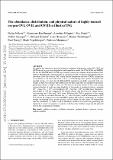| dc.contributor.author | Nelson, Dylan | |
| dc.contributor.author | Kauffmann, Guinevere | |
| dc.contributor.author | Pillepich, Annalisa | |
| dc.contributor.author | Genel, Shy | |
| dc.contributor.author | Springel, Volker | |
| dc.contributor.author | Pakmor, Rüdiger | |
| dc.contributor.author | Hernquist, Lars | |
| dc.contributor.author | Weinberger, Rainer | |
| dc.contributor.author | Torrey, Paul | |
| dc.contributor.author | Vogelsberger, Mark | |
| dc.contributor.author | Marinacci, Federico | |
| dc.date.accessioned | 2021-10-27T20:10:25Z | |
| dc.date.available | 2021-10-27T20:10:25Z | |
| dc.date.issued | 2018 | |
| dc.identifier.uri | https://hdl.handle.net/1721.1/135032 | |
| dc.description.abstract | © 2018 The Author(s). Published by Oxford University Press on behalf of the Royal Astronomical Society. We explore the abundance, spatial distribution, and physical properties of the OVI, OVII, and OVIII ions of oxygen in circumgalactic and intergalactic media (the CGM, IGM, and WHIM). We use the TNG100 and TNG300 large volume cosmological magnetohydrodynamical simulations. Modelling the ionization states of simulated oxygen, we find good agreement with observations of the low-redshiftOVI column density distribution function (CDDF), and present its evolution for all three ions from z = 0 to z = 4. Producing mock quasar absorption line spectral surveys, we show that the IllustrisTNG simulations are fully consistent with constraints on the OVI content of the CGM from COS-haloes and other low-redshift observations, producing columns as high as observed. We measure the total amount of mass and average column densities of each ion using hundreds of thousands of simulated galaxies spanning 1011 < Mhalo/M⊙ < 1015 corresponding to 109 < M/M⊙ < 1012 in stellar mass. Stacked radial profiles of OVI are computed in 3D number density and 2D projected column density, decomposing into 1-halo and 2-halo terms. Relating halo OVI to properties of the central galaxy, we find a correlation between the (g - r) colour of a galaxy and the total amount of OVI in its CGM. In comparison to the COS-Haloes finding, this leads to a dichotomy of columns around star-forming versus passive galaxies at fixed stellar (or halo) mass. We demonstrate that this correlation is a direct result of black hole feedback associated with quenching and represents a causal consequence of galactic-scale baryonic feedback impacting the physical state of the circumgalactic medium. | |
| dc.language.iso | en | |
| dc.publisher | Oxford University Press (OUP) | |
| dc.relation.isversionof | 10.1093/MNRAS/STY656 | |
| dc.rights | Creative Commons Attribution-Noncommercial-Share Alike | |
| dc.rights.uri | http://creativecommons.org/licenses/by-nc-sa/4.0/ | |
| dc.source | arXiv | |
| dc.title | The abundance, distribution, and physical nature of highly ionized oxygen O vi, O vii, and O viii in IllustrisTNG | |
| dc.type | Article | |
| dc.contributor.department | Massachusetts Institute of Technology. Department of Physics | |
| dc.contributor.department | MIT Kavli Institute for Astrophysics and Space Research | |
| dc.relation.journal | Monthly Notices of the Royal Astronomical Society | |
| dc.eprint.version | Author's final manuscript | |
| dc.type.uri | http://purl.org/eprint/type/JournalArticle | |
| eprint.status | http://purl.org/eprint/status/PeerReviewed | |
| dc.date.updated | 2019-06-10T10:49:35Z | |
| dspace.orderedauthors | Nelson, D; Kauffmann, G; Pillepich, A; Genel, S; Springel, V; Pakmor, R; Hernquist, L; Weinberger, R; Torrey, P; Vogelsberger, M; Marinacci, F | |
| dspace.date.submission | 2019-06-10T10:49:39Z | |
| mit.journal.volume | 477 | |
| mit.journal.issue | 1 | |
| mit.metadata.status | Authority Work and Publication Information Needed | |
